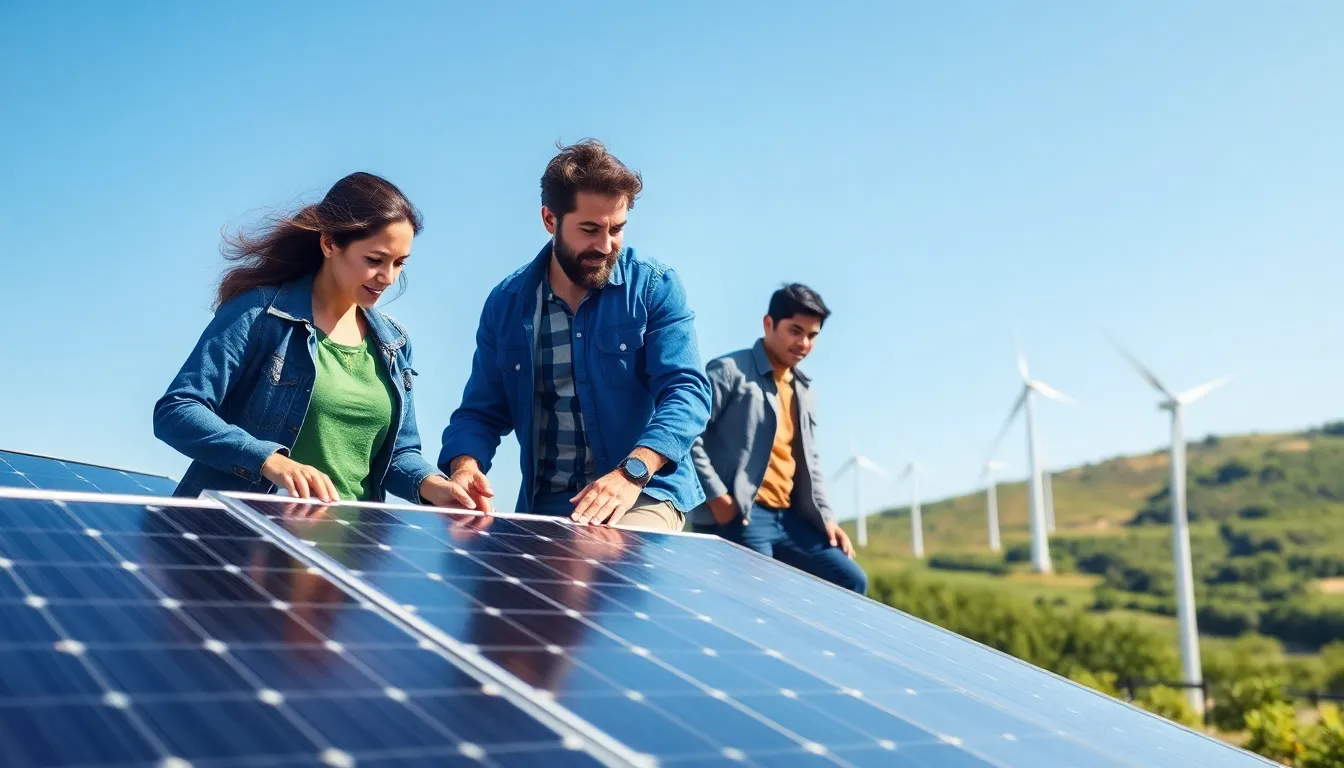In a world where plastic straws are the new villain and climate change feels like a bad sequel, sustainable living innovations are stepping up to save the day. It’s like watching a superhero movie, but instead of capes and tights, we’ve got solar panels and composting toilets. Who knew saving the planet could be this cool?
From smart homes that whisper sweet nothings to energy-efficient appliances that practically dance, these innovations are transforming the way people live. They’re not just about saving the Earth; they’re about making life easier, more enjoyable, and—dare we say—fun! So buckle up as we explore the latest and greatest in sustainable living innovations that’ll have you saying goodbye to waste and hello to a greener, cleaner lifestyle.
Table of Contents
ToggleOverview of Sustainable Living Innovations
Sustainable living innovations emerge as pivotal solutions to pressing environmental issues. Renewable energy technologies like solar panels lower reliance on fossil fuels, significantly reducing carbon footprints and electricity costs. Vertical gardens, which utilize limited space for growing food, provide fresh produce while purifying air quality.
Smart home devices contribute to sustainable living by optimizing energy usage. For instance, smart thermostats automatically adjust heating and cooling, resulting in lower energy bills. Water-saving appliances, such as low-flow faucets and efficient washing machines, dramatically reduce water consumption in households.
Composting toilets stand out as an innovative solution, decreasing water waste and promoting nutrient recycling. Rainwater harvesting systems enable users to collect and utilize rainwater for irrigation or household use, lessening the demand on municipal water supplies.
Electric vehicles have transformed transportation by offering a cleaner alternative to traditional gas-powered cars. As charging infrastructure improves, the adoption of these vehicles increases, which helps reduce urban air pollution.
Moreover, sustainable packaging has gained traction, with many companies opting for biodegradable materials instead of single-use plastics. Efforts in community-supported agriculture (CSA) strengthen local economies, connecting farms directly with consumers and minimizing food miles.
Innovative technologies and practices continually reshape daily living by prioritizing sustainability. They foster an eco-friendly lifestyle while simultaneously addressing environmental challenges, proving that a greener future is accessible and attainable.
Key Innovations in Sustainable Living

Sustainable living innovations lead the way toward a more eco-conscious future. These advancements not only address environmental challenges but also enhance everyday life.
Renewable Energy Solutions
Solar panels stand out among renewable energy solutions. They convert sunlight into electricity, significantly reducing reliance on fossil fuels. Wind turbines also play a crucial role, generating clean power, while geothermal systems use the Earth’s heat for heating and cooling. Hydropower utilizes flowing water to produce energy efficiently. Together, these technologies lower carbon footprints and promote energy independence.
Water Conservation Technologies
Water-saving appliances transform daily routines. Low-flow showerheads and faucets reduce water usage without sacrificing performance. Rainwater harvesting systems collect and store rainwater, providing a valuable resource for irrigation and non-potable applications. Smart irrigation systems optimize water use in gardens, adapting to weather patterns for maximum efficiency. These innovations significantly contribute to sustainable water management.
Eco-Friendly Transportation Options
Electric vehicles lead the charge in eco-friendly transportation. They produce zero tailpipe emissions, making them a cleaner alternative to traditional gas-powered cars. Car-sharing programs further reduce the number of vehicles on the road, decreasing traffic congestion. Public transport options like buses and trains connect communities while minimizing environmental impact. These options create a more sustainable approach to mobility.
Impact of Sustainable Living Innovations
Sustainable living innovations significantly influence environmental health and economic stability. These advancements promote a greener future while improving daily life.
Environmental Benefits
Sustainable living innovations actively reduce carbon emissions, helping to combat climate change. Renewable energy sources, such as solar panels and wind turbines, contribute to cleaner air by decreasing reliance on fossil fuels. Water-saving technologies, including low-flow fixtures and smart irrigation systems, enhance water conservation efforts. Vertical gardens improve urban spaces by filtering air and providing fresh produce. Electric vehicles further minimize pollution by offering a cleaner mode of transportation. Together, these innovations create healthier ecosystems and promote biodiversity, demonstrating a commitment to environmental stewardship.
Economic Advantages
Sustainable living innovations generate economic opportunities while fostering local economies. Implementing renewable energy solutions can lower energy costs for households and businesses. Community-supported agriculture (CSA) strengthens the local food economy, enabling consumers to purchase fresh produce directly from farmers. Investing in eco-friendly technologies creates jobs in emerging green industries. Additionally, energy-efficient appliances often provide savings on utility bills, allowing households to allocate funds elsewhere. By prioritizing sustainability, communities can achieve long-term economic resilience while reducing harmful environmental impacts.
Challenges and Future Prospects
Sustainable living innovations face significant challenges that impact their widespread adoption. High costs associated with new technologies deter many individuals and businesses from switching to greener options. Limited awareness of the benefits also plays a crucial role, as misinformation and a lack of education create barriers. Additionally, existing infrastructure often fails to support the integration of innovative solutions, slowing progress.
Emerging trends in sustainability offer hope for overcoming these challenges. The rise of eco-friendly materials, such as biodegradable plastics, shows promise in addressing waste issues. Increasingly, community engagement in local sustainability initiatives strengthens grassroots movements. Smart home technology continuously evolves, enhancing energy efficiency and convenience for users. Innovations like urban farming and regenerative agriculture gain traction, promoting food security and reducing transportation emissions. Collective efforts and technological advancements pave the way for a more sustainable future.
Sustainable living innovations represent a significant shift towards a healthier planet and improved quality of life. As these advancements continue to evolve they pave the way for a more eco-conscious society. By embracing technologies that prioritize sustainability individuals can contribute to a cleaner environment while enjoying the benefits of modern conveniences.
The journey towards sustainability is ongoing and requires collective effort. With continued innovation and community engagement the vision of a greener future becomes increasingly attainable. Each small step taken towards sustainable living not only enhances personal well-being but also fosters a global movement towards environmental stewardship.






